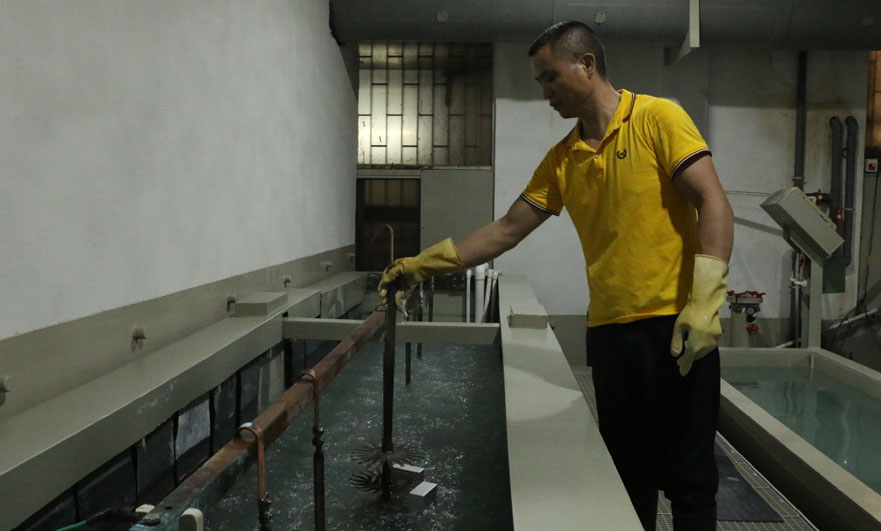15 years one-stop China custom CNC machining parts factory

Hey there I’m VMT Sam!
With 25 years of CNC machining experience we are committed to helping clients overcome 10000 complex part-processing challenges all to contribute to a better life through intelligent manufacturing. Contact us now
 128 |
Published by VMT at Jul 12 2021
128 |
Published by VMT at Jul 12 2021
After CNC machining precision metal parts, we usually do some treatment on the surface of the product. Surface treatment is a process of artificially forming a surface layer on the surface of the substrate that is different from the mechanical, physical and chemical properties of the substrate. After CNC machining precision metal parts, the special functional treatments of wear resistance, corrosion resistance, decoration, etc., of products without surface treatment cannot meet the ideal requirements. In order to meet the product's corrosion resistance, wear resistance, decoration or other special functional requirements, our more commonly used surface treatment methods include mechanical grinding, chemical treatment, surface heat treatment, surface spraying, etc. Clean and sweep the surface of the CNC machining precision metal parts, deburr, degrease, and deoxidize. Pay attention to VMT immediately to understand why surface treatment is needed and the benefits of surface treatment.
Common CNC machining precision metal parts surface treatment processes include: vacuum plating, electroplating process, anodizing, electrolytic polishing, pad printing process, galvanizing process, powder spraying, water transfer printing, screen printing, electrophoresis, etc.
Applicable materials:
1. Many materials can be vacuum electroplated, including metals, soft and hard plastics, composite materials, ceramics and glass. Among them, the most common CNC machining precision metal parts surface treatment for electroplating is aluminum, followed by silver and copper.
2. Natural materials are not suitable for vacuum plating, because the moisture of natural materials will affect the vacuum environment.
Process cost: In the vacuum plating process, the CNC machining precision metal parts workpiece needs to be sprayed, loaded, unloaded and re-sprayed, so the labor cost is quite high, but it also depends on the complexity and quantity of the workpiece.
Vacuum plating has very little environmental pollution, similar to the environmental impact of spraying.
Electroplating process
The process of attaching a metal film to the surface of the CNC machining precision metal parts through electrolysis prevents metal oxidation, improves wear resistance, conductivity, light reflection, corrosion resistance and enhances aesthetics. The outer layer of many coins is also electroplated.
Applicable materials:
1. Most cnc machining precision metal parts can be electroplated, but different metals have different purity and electroplating efficiency. The most common are: tin, chromium, nickel, silver, gold and rhodium.
2. The most commonly used plastic for electroplating is ABS.
3. Nickel metal cannot be used for electroplating CNC machining precision metal parts that contact the skin, because nickel is irritating and toxic to the skin.
Process cost:
No mold cost, but fixtures are required to fix the CNC machining precision metal parts/time cost depends on temperature and metal type/labor cost (medium-high), depending on the type of electroplated CNC machining precision metal parts, such as silverware and jewelry electroplating due to higher appearance and durability requirements, So the operation is performed by skilled workers.
Environmental impact:
A large number of toxic substances are used in the electroplating process, so professional diversion and extraction are required to ensure the minimum impact on the environment.
Electrolytic polishing
Electrolytic polishing refers to the atoms immersed in the electrolyte. Due to the passage of current, they are converted into ions and separated from the surface, so as to achieve the effect of removing fine burrs on the surface of the CNC machining precision metal parts workpiece and increasing the brightness.
Applicable materials:
1. Most metals can be electrolytically polished, of which the most commonly used for surface polishing of stainless steel CNC machining precision metal parts (especially suitable for austenitic nuclear grade stainless steel).
2. Different materials cannot be electropolished at the same time, or even put in the same electrolytic solvent.
Process cost:
The whole process of electrolytic polishing is basically completed by automation, and the labor cost is extremely low.
Environmental impact:
Electrolytic polishing uses fewer harmful chemicals. The whole process consumes little water and is easy to operate. In addition, it can extend the performance of stainless steel and delay the corrosion of stainless steel.
Anodizing
It is mainly the anodization of aluminum CNC machining precision metal parts, which uses electrochemical principles to form a layer of Al2O3 (alumina) film on the surface of aluminum and aluminum alloys. This oxide film has special characteristics such as protection, decoration, insulation, and wear resistance.
Applicable materials:
aluminum, aluminum alloy and other aluminum CNC machining precision metal parts.
Process cost:
In the production process, the consumption of water and electricity is quite large, especially the oxidation process. The heat consumption of the machine itself needs to be continuously cooled with circulating water, and the power consumption is often around 1000 degrees.
Environmental impact:
Anodizing is not excellent in terms of energy efficiency. At the same time, in the production of aluminum electrolysis, the anode effect will also produce gases that cause destructive side effects on the atmospheric ozone layer.
There are two explanations for CNC machining precision metal parts surface treatment. One is extensive surface treatment. One process includes chemical, electroplating, painting, chemical, thermal and other physical and chemical methods; the other is surface treatment in a narrow sense. , Only includes pretreatment such as sandblasting and polishing. Today’s sharing is over, if you want to know more, please consult our official website customer service, thank you.
Ready To Start Your Next Project?
Get Instant Quote

Request a Free Quote
Send us a message if you have any questions or request a quote. We will get back to you ASAP!
